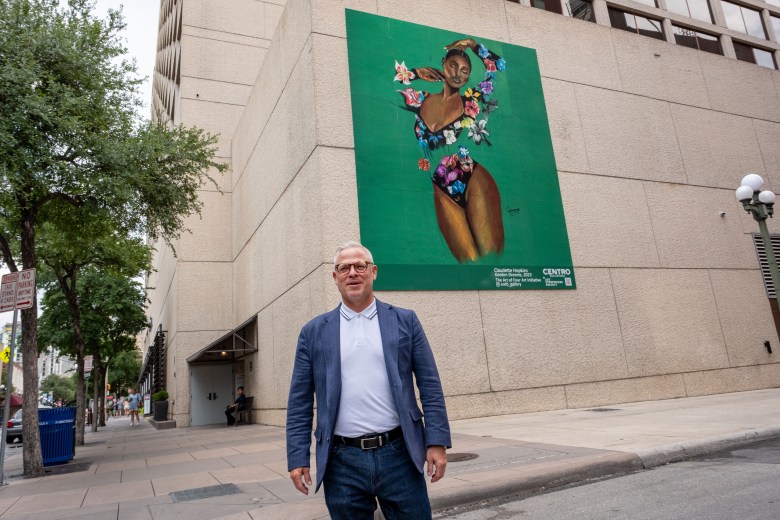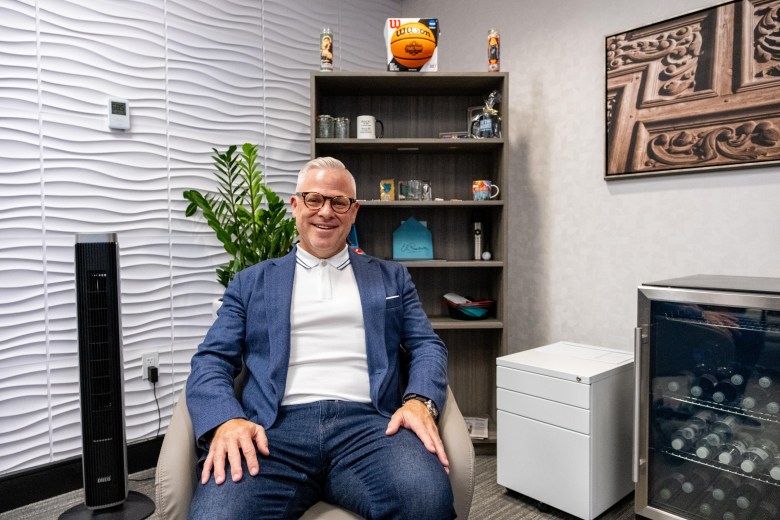In the heart of downtown San Antonio, Mario J. Bass occupies a front row seat to an unimaginable adventure.
His own.
From behind his C-suite desk on the ground floor of 110 Losoya Street, Bass recalls an improbable journey.
At age 24, he rose from a South Side home off Nogalitos and Zarzamora to become a front desk clerk at the Marriott Rivercenter on the River Walk, earning $6 an hour.
Today, Bass, 53, leads the mission to market San Antonio as a leisure and convention destination.
“If somebody would have told me 30 years ago when I started my hospitality and tourism career that I’d be sitting here as President and CEO of Visit San Antonio, I would have said, “You’re nuts,” said Bass, whose office sits in the shadow of the city’s expanding skyline. “That wasn’t on my Mexican bingo card.”
In his youth, Bass held a limited view of the city. “Anything beyond downtown,” he said, “was the North Side.” A big family outing was attending a parade or visiting the Riverwalk. Eating out meant going to a taqueria. For special occasions, they’d hit Bonanza Steakhouse.
Back in the day, Bass aspired to a career in advertising. He attended Burbank High School, graduated from East Central High School and earned an associate’s degree in hotel/motel administration and management from St. Philip’s College. With that education, he landed a near-minimum wage desk job at the Rivercenter Hotel.
From there, Bass began a long and remarkable climb through the hospitality industry. Stops included management positions at the New York Marriott Marquis, the JW Marriott San Antonio Hill Country Resort & Spa and Visit Orlando.
 Mario Bass walks beneath a Centro San Antonio “Art Everywhere Project” mural displayed on the corner of Losoya and College Street in Downtown San Antonio. Credit: Amber Esparza for the San Antonio Report
Mario Bass walks beneath a Centro San Antonio “Art Everywhere Project” mural displayed on the corner of Losoya and College Street in Downtown San Antonio. Credit: Amber Esparza for the San Antonio Report
“This is my eighth move,” he said. “Anytime I move somewhere, from the day I start, I’m always thinking, ‘How can I get back to San Antonio? How do I get back home?’”
He returned to his hometown in 2024 as executive vice president and chief strategy officer at Visit San Antonio and became president and CEO on June 2, taking oveer for Marc Anderson, who exited this spring after four years at the helm.
Bass is the first native to lead Visit San Antonio since the 2017 establishment of the destination marketing organization.
The San Antonio Report sat down with Bass to discuss his role as CEO, tourism, Project Marvel and the challenges facing the hospitality industry. This interview has been edited for length and clarity.
San Antonio Report: What is your primary objective as President and CEO?
Mario Bass: To bolster the core mission of our organization, which is selling and marketing the city of San Antonio to both the group and leisure customer. If you want to simplify it, it’s “heads in beds.” I want to make sure that everything we do as an organization is driving the hot (hotel occupancy) tax and sales tax to our destination.
SAR: From the time you were in high school until today, what are the biggest changes you’ve seen in the city?
MB: Thirty years ago, we were the Alamo and the Riverwalk. There were other missions, certainly. But fast forward 30 years later and look at the changes: Pearl District, Southtown, downtown, Blue Star, the arts district. And then you go off to the northern portion of town where you have The Shops at La Cantera, the No. 1-rated shopping facility in the country.
SAR: What are the tourism numbers today compared to pre-pandemic San Antonio? In 2019, the city attracted 41 million visitors.
MB: We had 35.6 million visits in 2023 (the totals for 2024 are not yet available). In a typical year, we’re closer to 38 million. As we came into January of this year, there was the onset of uncertainty, the headwinds, talks of tariffs, international travel concerns, restrictions. All that put a damper on what we’re doing. If the January uncertainty hadn’t happened, I think we would probably start at a trend closer to those pre-pandemic numbers. We’re still not quite there.
SAR: How does San Antonio recover from that?
MB: The best thing we can do is get back to basics. We need to own our own backyard. Make sure we’re taking advantage of the 40 million-plus Texans who live in the surrounding area that call San Antonio their second home. They are still concerned about their pocketbooks. But they will travel within a five-hour window of their destination and that bodes well for San Antonio. The other thing is we have to ensure we have a very strong group base. And you do that by assuring that the organization is laser focused on everything we can control to put heads in beds.
SAR: What are the greatest challenges to the recovery of visitors since COVID-19?
MB: Economic uncertainty. Concerns about international travel and visas. Getting in and out of the U.S. And tariffs. And that goes back to why I have an intense focus on the group segment for our destination. Because, yes, they’re impacted by that economic headwind but they’re a lot less fickle than the leisure traveler. We love the leisure traveler. They comprise 70 percent or so of the mix coming into our destination. But the problem is, they’re impacted by weather. If it’s 110 degrees out, they’re not coming. If it’s raining out, they look at their weather app. “Oh, maybe not this weekend.” But the group customer, we’ll book those 10 years out. They have contracts. They’re going to be here, rain or shine.
SAR: San Antonio is building more hotels while hotel occupancy is on the decline. It’s down 8.2 percent in the first quarter compared to last year and down 19 percent compared to 2019. Why build?
MB: Because they’re not just building for today. They’re building for a future. And not only that, they’re betting on the past. San Antonio has been and always will be a destination that people want to visit. There’s 300 years of history of the people of San Antonio and the warm-hearted culture.
SAR: What can the city do to reverse the decline in hotel occupancy?
MB: We’ve got 18 more gates that are getting ready to come online at San Antonio International Airport. That’s going to add more flights into the destination. We want to make sure we’re capitalizing on that, along with 10 additional direct flights, many of those supporting Mexico. That’s how we get it.
SAR: How will Project Marvel, the proposed sports and entertainment district downtown, impact hotel occupancy and convention business?
MB: Project Marvel will be a game-changer for us. It will give us an additional 200,000 square feet of contiguous exhibit hall space. We have found there’s another billion dollars worth of economic impact if we have that space. Now we still have to go get it. We still have to go sell and market and get it here. But without that 200,000 square feet, they (conventioneers) are not coming. You have to have it.
The convention footprint and walkability of downtown is what meeting planners love. They also know that within one to two blocks there’s 4,000 hotel rooms around the convention center. No additional transportation costs. I can walk right out of my hotel room and walk right into the convention center. You’ve just added convenience and logistics for that meeting planner.
 Visit San Antonio President and CEO Mario Bass poses for a photo in his office July 14. Credit: Amber Esparza for the San Antonio Report
Visit San Antonio President and CEO Mario Bass poses for a photo in his office July 14. Credit: Amber Esparza for the San Antonio Report
SAR: If Project Marvel unfolds as planned, how will it affect tourism?
MB: It shoots us right out of a cannon. The entire sports and entertainment project itself, with the Spurs coming back to downtown, will be adding entertainment, nightlife and restaurants. Developers have seen this at Texas Live! in Arlington and at L.A. Live in Los Angeles. Those are proven sports and entertainment districts that have transformed the urban core of those destinations.
SAR: Other Texas cities are investing billions of dollars to expand their convention centers. How will Project Marvel help San Antonio be more competitive with Dallas, Austin and Houston?
MB: We can’t afford not to do this. You’ve got Austin going through their four-year transformation completely offline. Dallas is going through their plan, which continues to evolve based on the economics of the buildout. Houston is looking at investing $2 billion into their convention center footprint. This is not the time to retreat in terms of development and investment into the infrastructure.
SAR: What excites you about San Antonio’s future?
MB: The city continues to invest and bet on itself. And this sports and entertainment district is part of that conversation. The investment into the San Antonio International Airport is a city saying, “We know who we are and we know where we’re going and we’re going to invest in that.” That excites me.
We have exciting projects in the pipeline. The re-imagination of the Alamo and Alamo Plaza. Civic Park. The Pearl. San Antonio has so much to offer.
The future is certainly bright for tourism because all of these game-changing resources will just bolster that space. I’m excited because I’m able to do this in my own backyard. Rarely do individuals get an opportunity to grow up in a destination — a tourism space — and do this dream job in their own backyard.
So the way I go about selling and marketing the city as the head of the organization is vastly different than somebody who was coming in and it wasn’t their home. Because I see the city through the lens of not only the guest and visitor experience, but also the impact it makes on me.
When I’m out and have the opportunity to speak to people — 5,000 person conferences, for example — the way I talk about my home is different than how I would talk about another destination. Because my heartstrings are attached to it. I am biased, to say the least, but this is a good place to be biased about.
